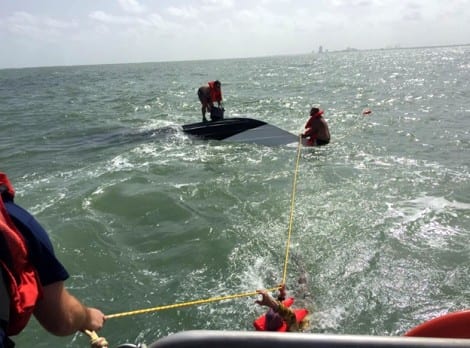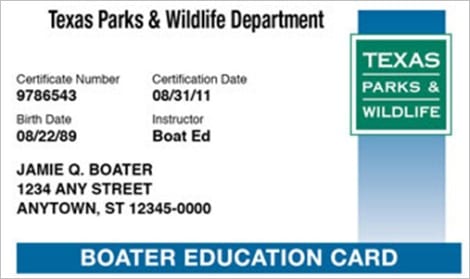 By Bob Currie, Vessel Examiner
By Bob Currie, Vessel Examiner
U.S. Coast Guard Auxiliary Station Galveston Flotilla.
The mission of the National Recreational Boating Safety (RBS) Program is “to ensure the public has a safe, secure, and enjoyable recreational boating experience by implementing programs that minimize the loss of life, personal injury, and property damage while cooperating with environmental and national security efforts.”
The Station Galveston Flotilla of the US Coast Guard Auxiliary operates out of the USCG Station Galveston base on Galveston Island. They provide assistance to the Coast Guard by providing maritime observation patrols in Galveston Bay; by providing recreational boating vessel safety checks; and by working alongside Coast Guard members in maritime accident investigation, small boat training, watch standing, and property administration.
The statistics in the bullet points below represent the latest efforts to compile and review the recreational boating accidents reported to the US Coast Guard via direct reporting and state reporting. It always takes a year to compile and analyze the reports, and to form a new plan to reduce the most common causes of recreational boating accidents. These statistics, therefore, are from 2017. The report for 2018 will come out in 2020, and so on.
Recreational Boating Accident Statistics Summary
-
- In 2017, the Coast Guard counted 4,291 accidents that involved 658 deaths, 2,629 injuries and approximately $46 million dollars of damage to property as a result of recreational boating accidents.
-
- The fatality rate was 5.5 deaths per 100,000 registered recreational vessels. This rate represents a 6.8% decrease from the 2016 fatality rate of 5.9 deaths per 100,000 registered recreational vessels.
- Compared to 2016, the number of accidents decreased 3.9%, the number of deaths decreased 6.1%, and the number of injuries decreased 9.4%.
- Where cause of death was known, 76% of fatal boating accident victims drowned. Of those drowning victims with reported life jacket usage, 84.5% were not wearing a life jacket.
- Where length was known, eight out of every ten boaters who drowned were using vessels less than 21 feet in length.
- Alcohol use is the leading known contributing factor in fatal boating accidents; where the primary cause was known, it was listed as the leading factor in 19% of deaths.
- Where instruction was known, 81% of deaths occurred on boats where the operator did not receive boating safety instruction. Only 14% percent of deaths occurred on vessels where the operator had received a nationally-approved boating safety education certificate.
- There were 172 accidents in which at least one person was struck by a propeller. Collectively, these accidents resulted in 31 deaths and 162 injuries.
- Operator inattention, improper lookout, operator inexperience, machinery failure, and alcohol use rank as the top five primary contributing factors in accidents.
- Where data was known, the most common vessel types involved in reported accidents were open motorboats (46%), personal watercraft (18%), and cabin motorboats (16%).
- Where data was known, the vessel types with the highest percentage of deaths were open motorboats (47%), kayaks (15%), and personal watercraft (7%).
- The 11,961,568 recreational vessels registered by the states in 2017 represent a 0.84% increase from last year when 11,861,811 recreational vessels were registered.
- A person dies; or
- A person disappears from the vessel under circumstances that indicate death or injury; or
- A person is injured and requires medical treatment beyond first aid; or
- Damage to vessels and other property totals $2,000 or more; or
- There is a complete loss of any vessel.
- Accident reports within 48 hours of an occurrence if:
- a. A person dies within 24 hours of the occurrence; or
- b. A person requires medical treatment beyond first aid; or
- c. A person disappears from the vessel.
- Accident reports within 10 days of an occurrence if there is damage to the vessel/property only.
- Always Wear a life Jacket
In 2017 76% of boating deaths were due to drowning, and in 84.5% of the drowning victims were not wearing a life jacket. Is a 15.5% chance of surviving an unplanned entry into the water really an acceptable risk? My favorite life jacket story involves a boater whose boat I was giving a free Vessel Safety Check. He was griping about the life jacket requirement, and said he didn’t need one because he was a “world class swimmer.” I asked him how well he could swim while unconscious. I hope that question gave him pause for thought. Of the 658 boating accident deaths, 500 were due to drowning. Of those 500 victims, 421 would probably have survived if they had been wearing a properly fitting Coast Guard approved life jacket. The captain of this charter boat below had never required anyone on board to wear a life jacket. When his boat capsized 5 miles offshore, his deckhand swam below the capsized boat and was able to pull some lifejackets from the storage locker. His captain said that from now on he would not leave the dock until everyone was wearing a life jacket. - Take a Boater Education Course
In 86% of the reported deaths, the victim had not taken a nationally-approved boater safety course. The course is free and can be taken online! Go to www.boat-ed.com/texas and sign up for the free online course. One gentleman whose boat I was giving a free Vessel Safety Check remarked that he took one of those courses back in ’75 when they first came out with it. I said great, so you can tell me the horn signal to give when you want to pass another boat on the right? Uh, no. What about the horn signal to give when you are about to get underway? Uh, no? What about the amount of time you have to report a boating accident? Nope. I said it may be time to retake the course. The purpose of taking the course is to give you information to help you boat safely. If that information has slipped away, it is time to retake the course.
- No Drinking and Boating
Alcohol was the leading contributing factor in boating deaths. Come on, now. This is a no-brainer. The boater safety course tells you that too. Operating a boat under the influence is against the law as well as being the leading contributing factor in boating deaths and injuries.
Accident Reporting as Required by Federal Law
Under federal regulations (33 CFR Part 173; Subpart C – Casualty and Accident Reporting) the operator of any numbered vessel that was not required to be inspected or a vessel that was operated for recreational purposes is required to file a Boating Accident Report when, as a result of an occurrence that involves the vessel or its equipment:If the above conditions are met, the federal regulations state that the operator or owner must report their accident to a state reporting authority. The reporting authority can be either the state where the accident occurred, the state in which the vessel was numbered, or, if the vessel does not have a number, the state where the vessel was principally used. The regulations also state the acceptable length of time in which the accident report must be submitted to the reporting authority. Boat operators or owners must submit:
Reducing Your Risk of Being a Statistic
As a species, our number one advantage for survival is our intellect. We don’t have a good sense of smell; we don’t have great vision; we can’t see in the dark well or over long distances; and we don’t have lightning reflexes and great strength. We generally rely on our observations and experiences in order to adopt safe practices. We weigh the risks and develop options. We know from experience and observation that if you place your hand on a hot stove you will get burned. The odds are high: 100%. Placing your hand on a hot stove is never an acceptable risk. The question is, at what percentage risk would it be acceptable? Would you put your hand on a hot stove if the risk were 85% that you would be burned? What about if the risk was that you would die from your burn? Would that change your mind about accepting the risk? These statistics from 2017 give us a pretty good idea of the risks involved with certain practices. You can reduce your risk and the risk of your passengers and other boaters on the water of becoming a statistic considerably by observing just three statistics and changing your habits. Here is how:

Summary
You can decrease your risk of being involved with a recreational boating accident considerably by doing just three things: always wear a life jacket, take (or retake) a safe boating course, and avoid alcohol while boating. These good habits are not only for your benefit and the benefit of your passengers, but they are also for the benefit of other innocent boaters with whom you could possibly collide.For more information on boating safety, please visit the Official Website of the U.S. Coast Guard’s Boating Safety Division at www.uscgboating.org. Questions about the US Coast Guard Auxiliary or our free Vessel Safety Check program may be directed to me at [email protected]. I am available to perform free Vessel Safety Checks, and I will come to your location to perform them. SAFE BOATING!
[3-5-2019]

 Posted in
Posted in 
























